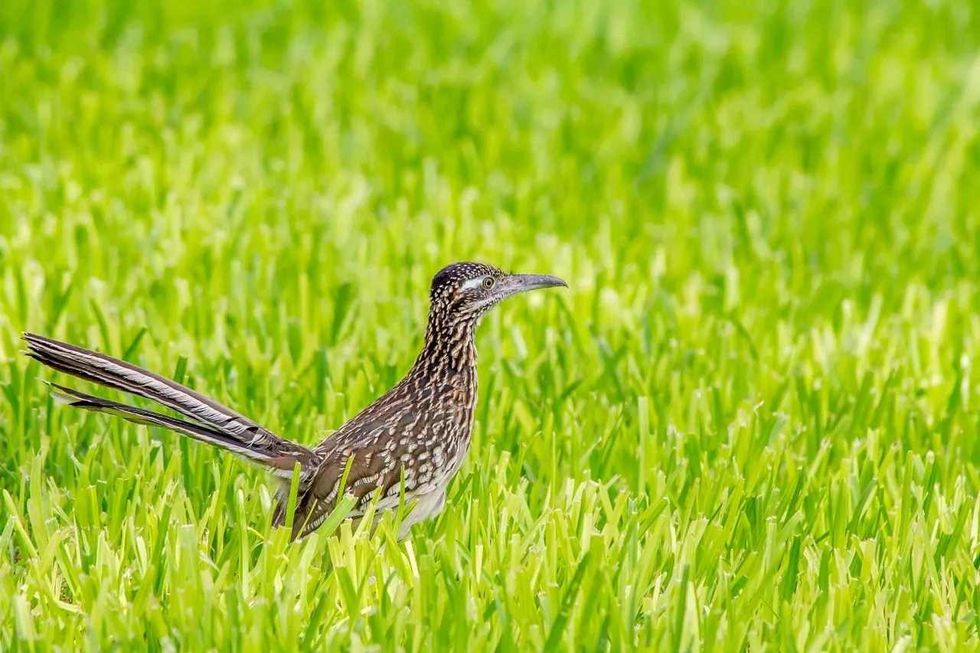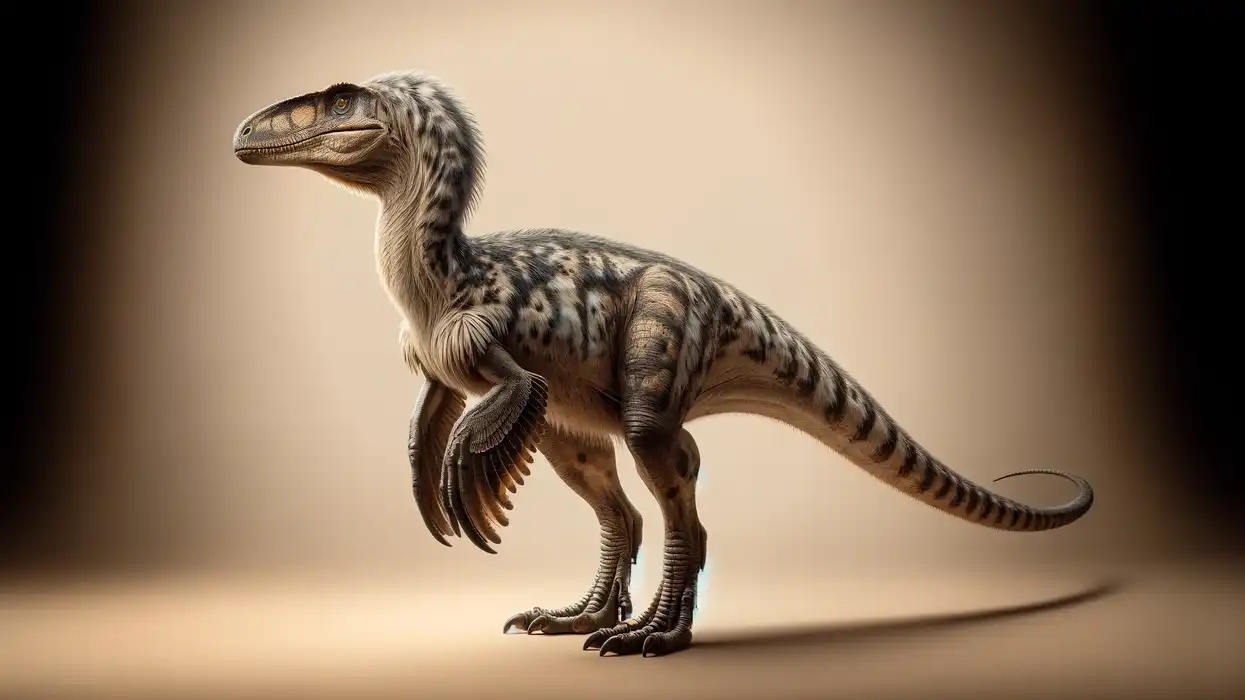The greater roadrunner belongs to the order Cuculiformes and is a member of the cuckoo family, Cuculidae. The scientific name for the greater roadrunner is Geococcyx californianus. This bird species is named after its habit of running towards cars on the road!
They possess a great running ability and can attain a speed of 17 mph (27.3 kph) on the ground. They are also known as ground cuckoos and the chaparral cock.
They are found in Arizona, Texas, and California. They also inhabit New Mexico. These birds have a distinct crest on top of their head that is made up of black feathers.
These birds breed once or twice a year, depending on the availability of food. The male bird attracts the female with its unique mating call at the breeding ground and displays courtship by offering them food. The nest site is built above the ground.
After mating, the female bird lays between two and six eggs. The juveniles are underdeveloped at birth and require parental care. Greater roadrunner predators include quails and hummingbirds.
If you liked reading this article then do check out our facts about the bowerbird and umbrellabird too!
Greater Roadrunner Interesting Facts
What type of animal is a greater roadrunner?
Greater roadrunners are a species of bird of the cuckoo family, Cuculidae. These birds belong to the order Cuculiformes.
What class of animal does a greater roadrunner belong to?
The greater roadrunner belongs to the class Aves.
How many greater roadrunners are there in the world?
The exact number of individual greater roadrunners present in the world is not known. They are known to have stable growth in their population.
Where does a greater roadrunner live?
These birds mostly reside in the southwestern United States and in Mexico. They are found in Arizona, California, Nevada, Colorado, Utah, Oklahoma, Arkansas, Texas, Missouri, and Louisiana. They also inhabit New Mexico. Their range overlaps with that of lesser roadrunners in the southern part of Mexico.
What is a greater roadrunner's habitat?
The preferred habitat of these birds is arid deserts. These deserts are characterized by extreme temperatures and get 1-8 in (25.4-203.2 cm) of annual rainfall. The vegetation is mostly comprised of cacti, grasses, and shrubs.
The typical greater roadrunner habitat during their breeding season is comprised of chaparral and scrub forests in coastal regions. The chaparral consists of dry summers and wet winters. The vegetation is comprised of evergreen shrubs, small trees, and bushes.
Who do greater roadrunners live with?
Greater roadrunners are known to live in pairs.
How long does a greater roadrunner live?
These birds have a lifespan of seven to eight years, four times longer than a common kingfisher.
How do they reproduce?
These birds are monogamous and have one partner throughout their lives. Their breeding season usually ranges from May to September. These birds breed once or twice a year and the male bird has a distinct mating call.
The male bird also tries to attract the female by offering them food. Both male and female birds build their nest in the breeding ground. After mating, the female bird lays between two and six eggs that are pale yellow or white in color.
Females incubate the eggs for about 20 days. Young birds are born in an underdeveloped state and require parental care. They develop quite fast and reach reproductive maturity between two and three years of age.
What is their conservation status?
The International Union for Conservation of Nature (IUCN Red List) has listed the greater roadrunner as a species of Least Concern. Despite this, habitat loss and climate change are some of the major threats these birds encounter.
Greater Roadrunner Fun Facts
What do greater roadrunners look like?
These birds have a dark brown or black plumage with a unique crest on their head. The crest is made up of black feathers. Their eye color is yellow and each eye contains a distinct red or blue streak.
Juveniles do not have colored streaks behind the eye and they have a bronze shade on their body. Their neck and upper breast are white with brown streaks. These birds have a long pair of legs that are blue in color.
They have a zygodactyl arrangement of digits, two toes face forward and two toes face backward. Their brown toes have golden spots on them. They have long tails and tail feathers.
How cute are they?
Their cuteness usually stems from their appearance. The presence of the unique crest on their head, their blue legs, and their bright yellow eyes with red or blue streaks make them cute.
How do they communicate?
These birds communicate through a wide range of vocalizations. The greater roadrunner sound is heard across a distance of about 820 ft (250 m).
A male greater roadrunner call is a cooing or whirring sound that is used to attract mates on the breeding ground. They also have a distinct alarm call which is produced by the repeated clicking of mandibles.
Their songs consist of a series of low coos in a slow, descending pitch. They also exhibit a unique courtship display where males wag their tales in a bowing posture in front of females.
How big is a greater roadrunner?
Adult greater roadrunners are usually between 19.6-24.4 in (50-62 cm) in length. They are larger than the common cuckoo or the European cuckoo, who are known to be 13 in (33 cm) in length and are also members of the cuckoo family.
Can a greater roadrunner fly?
Great roadrunners cannot fly for more than a few seconds. However, they are well adapted to run on the ground. The average greater roadrunner speed is highly acclaimed as they can reach around 17 mph (27.3 kph).
How much does a greater roadrunner weigh?
Greater roadrunners weigh around 8-12 oz (226.7-340.1 g).
What are the male and female names of the species?
Scientists do not have specific names for male and female greater roadrunner birds. They are commonly referred to as a male greater roadrunner and female greater roadrunner.
What would you call a baby greater roadrunner?
Baby greater roadrunners are known as chicks.
What do they eat?
The typical greater roadrunner diet mainly consists of cactus, scorpions, lizards, and snakes. They are also known to prey on rattlesnakes and a variety of mammals. Food resources of the young include spiders, tarantulas, and centipedes.
Are they dangerous?
Greater roadrunner (scientific name: Geococcyx californianus) birds are not considered to be dangerous. However, they are known to be territorial. Male birds often engage in physical fights to protect their territorial ground from predators or other birds. These birds also tend to approach humans out of their curious nature.
Would they make a good pet?
These birds do not make good pets. They are wild birds and do not adapt well to captivity. It is illegal to own greater roadrunners in many parts of the world.
Did you know...
These birds possess a wide range of adaptations to survive in a large variety of climatic conditions. Greater roadrunner adaptations include thermoregulation, through which they regulate their body temperature in arid deserts. They rest under the shade of a tree during mid-day when it is hottest.
They remain active from sunrise to mid-morning and again from late afternoon to evening. They can conserve water inside their body in the mucous membranes present in their rectum, caecum, and cloaca. This keeps their body temperature low and prevents dehydration.
Greater roadrunner vs. lesser roadrunner
The lesser roadrunner is comparatively smaller than the greater roadrunner bird, it has fewer streaks on the throat and neck region and a shorter bill. This is the main difference between greater and lesser roadrunners.
How is the greater roadrunner both a predator and prey?
Greater roadrunners prey on a variety of mammals, insects, and birds. They run hastily on the ground while hunting. They smash their prey on a solid object before swallowing it. However, they are also preyed on by adult sparrows, hummingbirds, and quails.
Here at Kidadl, we have carefully created lots of interesting family-friendly animal facts for everyone to discover! Learn more about some other birds from our red-winged blackbird facts and sunbird facts pages.
You can even occupy yourself at home by coloring in one of our free printable greater roadrunner coloring pages.









